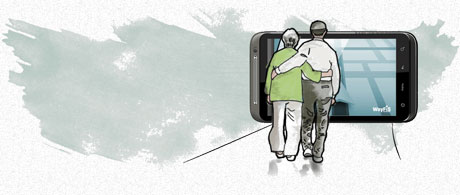by Mattia Gustarini, Katarzyna Wac and Dimitri Konstantas
The WayFis project is the first European AAL project to help the elderly plan personalized routes and guide them in complex paths in different contexts including indoors, outdoors, pedestrian, and on public transport.

The European WayFiS project (2011-2013), launched in the Ambient Assisted Living program aims to improve the capability of seniors to plan, manage and execute travel and transportation projects at their own discretion by solving the problems encountered by elderly people when trying to move in unknown indoor and outdoor environments, thus enabling them to take part in a self-serve society.
The problems addressed by this project are mainly related to access to information, sight problems, walking and/or motor abilities, cognitive abilities, associated health limitations and poor availability of proper information regarding transport options and accessibility of stations and stops. The target group constitutes people aged over 70 years old who are unfamiliar with ICT and with technologies in general, usually living alone and suffering from health limitations due to aging. The resulting WayFiS services will be tested in target groups in Spain, Hungary and possibly Switzerland.
The project involves six European partners: from Switzerland, the University of Geneva and the company Arx iT; from Spain, the companies HI-Iberia and Cetiex; and from Hungary, the research institute Bay Zoltán and the elderly care home Hársfalevél.
The innovation of WayFiS is the development of a personalized way-finding service for elderly people, considering both public transport and paths by foot, and focused on the objective of making the elderly feel healthy, well, and safe. It takes into account their specific limitations and health habits, with the challenge of aggregating a huge amount of information from different sources and including them into one mobile service with an intuitive interface (eg voice-touch-write). The WayFiS is the first route planning service for elderly people that considers both the pedestrian and public transportation mobility issues. It includes a wide range of personalization features based on the health state of the user and his common behaviours and needs. For example, it considers his ability to walk only a specific distance at once, the impossibility to walk on an uneven terrain or the difficulty in taking stairs in a bus. WayFiS also includes localization and positioning features for both indoor and outdoor environments that will guide the elderly along complex paths.
The success of WayFiS service will largely depend on use and usability of sources of information such as public transport maps, web-based and mobile services. To ensure its success, we will start the development of the project by defining detailed user scenarios, which will depend on the target population’s characteristics and needs and hence be specific to each participating country. Based on the defined scenarios, we will design the system and its services by delineating the WayFiS architecture and its components, which furthermore will serve as a basis for the system implementation. We have already discovered that availability of public transport information is very different in each participating country, which will, to a large extent, influence the way the system is deployed there. With respect to the deployment platform, owing to its openness and flexibility, we define an Android operating system as a target system for WayFiS deployment.
The evaluation of the WayFiS will be done with its end-users and will include quantitative as well as qualitative evaluation procedures. Namely, based on measurements-based performance evaluation methods, we will quantify WayFiS service speed, accuracy, dependability and scalability for a real-time, continuous navigation of seniors in real-life environments. Furthermore, we will employ evaluation methods from the human-computer interaction domain in order to evaluate WayFiS usability, interface design and effectiveness of service interactions on mobile devices. These methods will be employed in at least two stages, ie involving first young and healthy student volunteers to get their initial feedback, and then the target end-users at a later stage of system development.
Links:
http://www.wayfis.eu/
http://www.qol.unige.ch/
Please contact:
Mattia Gustarini
Université de Genève, Switzerland
Tel: +41 22 379 02 46
E-mail:










